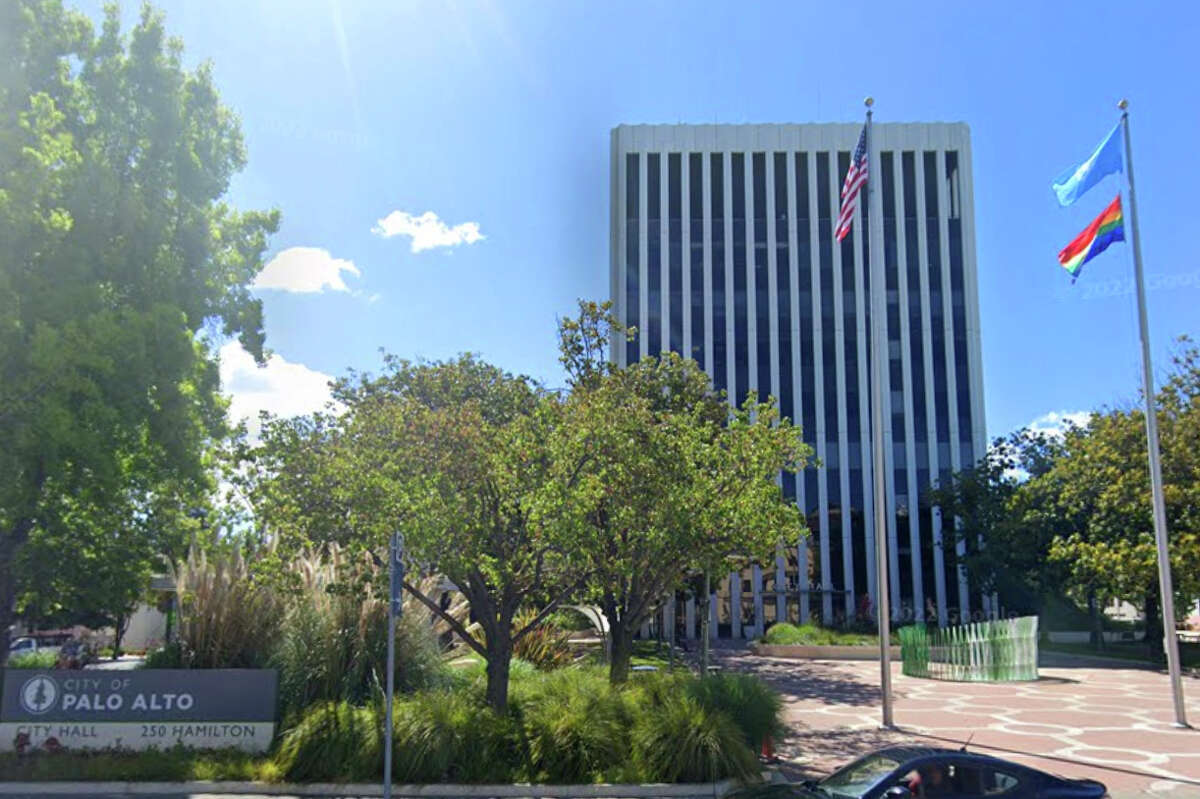https://www.sfgate.com/politics/article/palo-alto-housing-element-in-limbo-18116958.phpAlec Regimbal,
SFGATE | May 31, 2023
Palo Alto City Hall in Palo Alto, Calif. Until the city gets its housing element approved, it’ll have to deal with the consequences from its failure to get that plan ratified before the state’s January deadline.
Palo Alto City Hall in Palo Alto, Calif. Until the city gets its housing element approved, it’ll have to deal with the consequences from its failure to get that plan ratified before the state’s January deadline.SFGATE via Google
The city of Palo Alto is waiting on state officials to approve the second version of a plan that maps out how the city will make way for more than 6,000 new housing units between now and 2031. Until the state approves that blueprint, however, the city has opened itself up to a string of consequences stemming from its failure to get a formal housing plan approved by state officials by the January deadline.
The first of those consequences is a lawsuit brought against the city by two pro-housing groups, YIMBY (an acronym for “yes in my backyard”) Law and the California Housing Defense Fund. Those groups, along with Californians for Homeownership, filed several lawsuits against Bay Area cities in February for failing to adopt housing formal plans by the state’s deadline.
Dylan Casey, the executive director of the California Housing Defense Fund, told SFGATE that the aim of those lawsuits is to light a fire under city officials — saying that without legal intervention, nothing would force cities like Palo Alto to come into compliance with state law.
“There’s a number of consequences to falling behind on this process written into the law, and without judicial enforcement, it wasn’t clear that any of those consequences would be a threat that would push these cities to get good, compliant plans written,” he said. “The law doesn’t enforce itself.”
Palo Alto, like dozens of other Bay Area cities, had its so-called “housing element” rejected by the state Department of Housing and Community Development (HCD) earlier this year. That agency requires individual localities to submit detailed plans for developing a state-determined number of new housing units once every eight years, and state officials have been very ambitious in their asks this cycle.
Palo Alto, for example, needs to plan for 6,086 new housing units between now and 2031 — a figure that’s more than three times the number of new units the state asked for during the city’s previous housing cycle.
In response, the city submitted its new housing plan in December, about a month before the state’s Jan. 31 deadline, but the HCD rejected it in March, saying in a 14-page letter that the new plan needed significant revisions. The city then approved a revised plan during an emotional joint meeting of the council and the city’s Planning and Transportation Commission on May 8.
While the plan was approved unanimously by the planning commission, and by six of the seven council members, it was clear that the revisions weren’t well-liked. Members seemed eager to approve the plan anyway, believing that simply having a plan in place was better than taking time to craft one that pleased everybody.
The most vocal critic of the new plan was Mayor Lydia Kou, the lone dissenting vote on the council. She lambasted the housing element process during her remarks before the final vote, saying there’s “little evidence” that the process actually makes homes more affordable. She also said the state’s method for determining the number of new housing units to be built was “flawed beyond logic,” and bemoaned the idea of the state pushing “unfunded mandates” on charter cities like Palo Alto.
Kou’s rhetoric matched that of city leaders in nearby localities such as Atherton, Hillsborough and Woodside, where city leaders lamented the idea of having to add new multi-family housing, and even weighed methods for skirting state law.
Casey said the potential consequences for cities without housing plans in place include the loss of state funding and a suspension on issuing nonresidential building permits, as well as the potential for a court order that would force the city to adopt a compliant housing plan within 120 days.
“We haven’t gotten to that stage quite yet, but we need to initiate these suits to ensure those various consequences would be on the table, and to produce a sense of urgency,” he said.
However, arguably the most consequential penalty for noncompliant cities is that they’re subject to what’s known as the “builder’s remedy.” That provision, adopted by the state in the 1990, allows developers to ignore local zoning standards on new projects in such cities as long as a certain amount of the project space is dedicated for use as affordable housing — but, at least in the Bay Area, those projects have largely struggled to get off the ground.
At least two such projects are already in the planning stages in Palo Alto, according to city documents: A five-story residential building with space for 45 units at 300 Lambert Ave., and a potentially 88-foot-tall residential building at 3997 Fabian Way with room for 350 housing units.
It’s unclear what would happen to those projects if Palo Alto were to come into compliance before they were complete, but a 2022 legal analysis of the state’s builder’s remedy by UCLA said that developers would have a strong argument that any sort of retroactive denial would be unlawful. There are, however, strategies that the city could employ to potentially derail the two projects, including taking the developers to court or requiring them to make costly changes to the projects if environmental reviews reveal flaws.
Whether the city will employ any of those strategies is uncertain, as officials have been mum about the projects so far. Pat Burt, a member of the city council, told SFGATE that the situation is out of the council’s hands while they await the HCD’s second ruling, and John Favreau — the developer of the Fabian Way project — told SFGATE he hasn’t even heard from the city since filing his application earlier this month.
However, one stipulation of the lawsuits brought against noncompliant cities in the Bay Area by the three pro-housing groups is that those cities, if they lose in court, must formally acknowledge that they were subject to the builder’s remedy while they didn’t have a formal plan in place. Casey said that acknowledgment could provide legal cover for developers who begin projects during that time.
Keith Diggs — an attorney with YIMBY Law — echoed Casey, saying the purpose of that element of the lawsuit is to provide a level of certainty to developers.
“I think what we’re potentially providing for the affordable housing community is certainty,” he said. “We are aware that there have been a lot of questions and uncertainty about what the city will do, so if we can get a court to rule that the builder’s remedy applies to preliminary applications that were filed at this certain time, it’s the least we can do.”
Both Casey and Diggs said that their respective groups will take a look at the city’s new housing element if it’s approved by HCD, and will file a separate joint lawsuit regardless of the HCD’s ruling if they feel it doesn’t go far enough to provide more housing. As for their current lawsuit, the group had its first hearing in front of Santa Clara County Superior Court earlier this month, and has a second hearing scheduled for the end of June.
Diggs also pushed back on the idea that cities may view the builder’s remedy as a problem they have to deal with, rather than an opportunity to make good on their promises to build more housing.
“Housing is a basic human necessity. When it’s too expensive or is just plain unavailable, it makes everything else more difficult for the people who weren’t lucky enough to have bought in during the ’60s and the ’70s or whatever, when it was cheap,” he said. “So I would love to see cities just drop this line that the builder’s remedy is like a penalty or a problem. We want to see cities welcoming new neighbors.”
Alec Regimbal is a politics reporter at SFGATE. He graduated from Western Washington University with a bachelor’s degree in journalism. A Washington State native, Alec previously wrote for the Yakima Herald-Republic and Seattle Post-Intelligencer. He also spent two years as a political aide in the Washington State Legislature.


